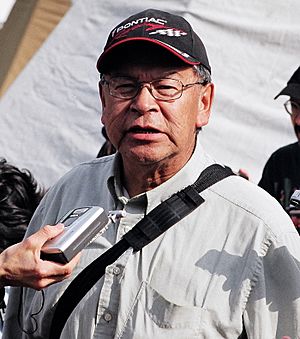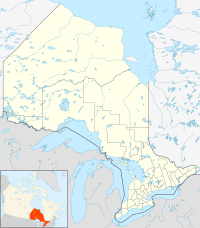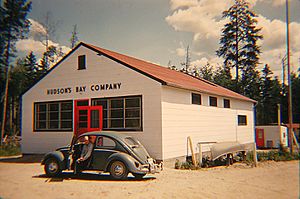Asubpeeschoseewagong First Nation facts for kids
Quick facts for kids
English River 21
Asabiinyashkosiwagong
|
|
|---|---|
| English River Indian Reserve No. 21 | |
| Country | Canada |
| Province | Ontario |
| District | Kenora |
| First Nations | Asubpeeschoseewagong |
| Area | |
| • Land | 39.69 km2 (15.32 sq mi) |
| Population
(2023)
|
|
| • Total | 1,608 |
| • Density | 16.1/km2 (42/sq mi) |
The Asubpeeschoseewagong First Nation, also known as Grassy Narrows First Nation, is an Ojibwe First Nations community. They live in northern Kenora in Ontario, Canada. Their home is the English River 21 Indian Reserve, which is about 41.45 square kilometers. As of October 2023, there were 1,608 registered members. The community signed Treaty 3 with the Canadian government.
Contents
Understanding the Environmental Challenges
The people of Grassy Narrows have faced serious environmental problems for many years. Between 1962 and 1970, a paper mill in Dryden, Ontario, released about ten tons of mercury into the Wabigoon River. This river is about 100 kilometers upstream from Grassy Narrows. The mercury poisoned the water and the fish, which were a main food source for the community.
For a long time, from around 2013 to October 2020, the community had a warning about their drinking water. This warning meant the water was not safe to drink without boiling. In 2020, the Canadian government agreed to build a $20 million health clinic. This clinic will help those suffering from mercury poisoning.
How Grassy Narrows is Governed
The Grassy Narrows First Nation has its own leaders. The current Chief is Randy Fobister, elected in 2020. There are also four councillors: Cody Keewatin, Art Anderson, Roy Assin, and Arnold Pahpasay Jr. These leaders make decisions for the community.
The First Nation is part of the Bimose Tribal Council. This council helps different First Nations work together. The Bimose Tribal Council is also part of the Grand Council of Treaty 3. This larger group works on political issues for many First Nations.
The reserve is also part of larger government areas. It is in the provincial area called Kenora-Rainy River. It is also in the federal area called Kenora.
A Look at Grassy Narrows History
Early Beginnings of the Community
The Asubpeeschoseewagong people say they have always lived along the Wabigoon River. This river flows past Dryden, Ontario, and joins the English River. It is located northeast of Lake of the Woods.
Historians believe the ancestors of the Northern Ojibway first met Europeans near Sault Ste. Marie, Ontario. They were called Saulteaux. Their land was along the northern shore of the Great Lakes. They became involved in the North American fur trade. They moved to their current location to find good places for trapping animals.
Life in the 1800s
In 1871, Grassy Narrows First Nation and other Ojibway tribes signed Treaty 3 with the Canadian government. This treaty meant they gave up rights to a large area of land. In return, they received a large piece of land, about one square mile for each family, along the Wabigoon-English River system.
The treaty allowed them to hunt, fish, and trap on parts of their old lands that were not being used. The government also promised to build schools. They would also provide hunting supplies, fishing nets, farming tools, and a small amount of money. Alcohol was not allowed on the reserve.
Life on the reserve followed traditional Ojibway ways. People lived off the land. Each family lived in log cabins, often far from their neighbors. They chose their homes based on access to good fishing and hunting spots. They also looked for places suitable for gardening.
Winters were spent trapping for the Hudson's Bay Company. Summers were for gardening and picking wild blueberries. These, along with animal skins, were sold for supplies. They grew potatoes in a community garden. In the fall, they harvested wild rice from the rivers. Muskrat were hunted for food and fur. Deer and moose were also hunted. Fish was a very important part of their diet. Some people worked as guides for tourists who came to fish. White people rarely entered the reserve, except for the treaty agent who visited once a year. The only way to reach the reserve was by canoe or plane.
Treaty 3 gave the Ojibway the right to use their traditional lands for harvesting. This was allowed until the lands were "taken up" for settlement or industry.
Changes from 1900 to 1950
From 1876 to 1969, many children from Grassy Narrows went to McIntosh Indian Residential School. This was a residential school in McIntosh, Ontario. The school was located by Canyon Lake. Supplies and students often arrived by barge.
In 1912, the land known as Keewatin became part of Ontario.
Until the late 1940s, the Grassy Narrows community managed its own economy. But in 1947-1948, the Ontario government started to control resource management and licensing. This meant they began regulating how people could use natural resources like forests and fish.
Events from 1950 to 2000
In 1963, the Canadian government moved the Grassy Narrows community to a new reserve. This new reserve was next to the English-Wabigoon River.
Between 1962 and 1970, a company called Dryden Chemicals Ltd. released about nine or ten tons of mercury into the Wabigoon River. This river was 100 kilometers upstream from Grassy Narrows. This mercury poisoned the fish, which were a main food source for the First Nation. This is considered one of Canada's worst environmental disasters.
In 1975, a doctor named Masazumi Harada tested mercury levels in people from Grassy Narrows. He found that their levels were much higher than what was considered safe. He returned in 2004 and found that many of the people with high mercury levels had passed away.
In 1985, the company that owned the mill, Reed Paper Company, along with the Canadian and Ontario governments, gave about $17 million in compensation to Grassy Narrows and Wabaseemoong First Nations. This was to help with the health effects of mercury. Also in 1985, Ontario agreed to take on all environmental responsibilities for the mill's mercury dumping.
A book written in 1985, Poison Stronger than Love: The Destruction of an Ojibwa Community, described how the mercury contamination affected the community. It showed how the community's spirit and way of life were harmed by the poisoned river and fish.
In 1997, the Ontario government allowed a company to clear-cut trees on the First Nation's traditional territory.
The 2000s and Beyond
In 2002, community members started the Grassy Narrows road blockade. This was to stop clearcutting on their land. The blockade was still active in 2023.
In 2005, Grassy Narrows challenged Ontario's logging license in court. They wanted to stop the logging. The court initially sided with Grassy Narrows. However, a higher court later said that Ontario had the right to sell the land. Discussions began in 2007 between Ontario and Grassy Narrows about forestry issues.
In the early 2010s, the Ontario government ordered companies to clean up a mercury waste site near Grassy Narrows. This site was where toxic material from the pulp and paper mill entered the river system in the 1960s.
In 2014, the Supreme Court of Canada ruled that Ontario had the right to limit First Nation harvesting rights on Treaty 3 land.
A report in 2016 showed that Ontario authorities knew decades ago that the mill site was contaminated with mercury. This report included old company records showing very high mercury levels in groundwater. In 2016, Ontario's Ministry of the Environment said no cleanup was needed beyond natural processes. However, a former mill worker later said he had helped dump drums of mercury into a pit behind the mill in the early 1970s.
In 2019, the Supreme Court of Canada ruled that two companies, Weyerhaeuser Company and Resolute Forest Products, are responsible for cleaning the mercury-contaminated site. This decision brought some clarity to the long-running dispute.
Protecting the Environment
Timber Harvesting Concerns
On September 8, 2007, Ontario agreed to discuss forestry issues with Grassy Narrows First Nation. These talks focused on how to manage forests sustainably. They also discussed harvesting methods and protecting traditional activities.
Another environmental concern for the reserve is the large-scale cutting of trees for paper. A company called Abitibi-Consolidated has been cutting trees in the area. Local people have asked the company and the Ministry of Natural Resources to use a more selective logging process. The community worries that large-scale logging will harm the local environment.
In August 2011, First Nation supporters won a court victory. An Ontario court ruled that the province cannot allow logging if it harms federal treaty promises. These promises protect Indigenous rights to hunt and trap. However, no immediate orders were given to stop logging.
In December 2014, a request for an environmental study into the impact of clear-cut logging was denied. Later documents showed that local biologists had concerns that were not addressed.
Community Services and Travel
The reserve is connected to other areas by local roads that link to Highway 671. This highway goes to Kenora, which is about 68.7 kilometers south.
The closest airport is Kenora Airport. From there, people can fly to larger cities like Thunder Bay and Winnipeg.
The reserve has one school, Sakatcheway Anishinabe School. It serves students from junior kindergarten to grade 12. Before this, many students went to McIntosh Indian Residential School.
A medical center provides basic health care during the week. There is no hospital on the reserve. For more serious care, people must go to Kenora.
The Treaty Three Police Service provides policing for the reserve.
Mercury Contamination in Grassy Narrows

The First Nations people experienced mercury poisoning from a chemical plant in Dryden. This plant supplied chemicals for bleaching paper at the Dryden Pulp and Paper Company. The chemical company released its waste into the Wabigoon-English River system. It is believed that about 10 tons (20,000 pounds) of mercury were dumped into the river system between 1962 and 1970. Both the paper and chemical companies stopped operating in 1976.
However, the mercury levels in the river system have not gone down as much as people were told. Workers from the industry have said that there are hidden mercury containers near the Wabigoon River. This has caused ongoing health problems for the Asubpeeschoseewagong First Nation. The chemical waste has also affected other water sources that connect to the Wabigoon River, like Clay Lake. It has also impacted the health of the Wabaseemoong First Nation community further downstream.
The mercury poisoning happened partly because environmental pollution laws were not very strict at the time. The Ontario provincial government initially told the First Nation community to stop eating fish. Fish was their main source of protein. They also closed down their commercial fishing business. This caused serious economic problems, leading to high unemployment. The closure of the fishery also hurt the local tourism industry, where community members worked as fishing guides. Because the fish are not safe to eat, the fishing tourism industry no longer exists.
Grassy Narrows First Nation received a settlement in 1985 from the Government of Canada and the company that bought the Dryden mill. In June 2017, the Ontario government promised $85 million to clean up the mercury. However, the mercury has not been removed from the water and continues to affect the health of Grassy Narrows residents. Government agencies are concerned that trying to remove the mercury from the riverbed might actually increase mercury levels downstream.
As of 2012, Health Canada said the amount of mercury in fish was low, but a health warning is still in place. People in the area still eat fish, especially pickerel (walleye), which is a local favorite. However, walleye are high on the food chain and can contain high levels of mercury. Walleye can have 13-15 times the recommended mercury levels. For pregnant women, children, and women who plan to have children, walleye can have 40-90 times the advisable mercury intake limit.
Some health problems linked to eating mercury-contaminated fish include numbness, hearing loss, headaches, dizziness, and limb cramps. Studies have also found that people in the Asubpeeschoseewagong First Nation have experienced high blood pressure, stroke, and lung, stomach, psychiatric, bone, and heart diseases. Even with these health issues, the community continues to eat fish from these waters. This is partly because they cannot afford boats to fish farther away or buy expensive groceries.
The ongoing consumption of fish in this region is also linked to the community's socioeconomic status and the important role fish plays in their culture.
See Also
- Mercury contamination in Grassy Narrows, Ontario, Canada



